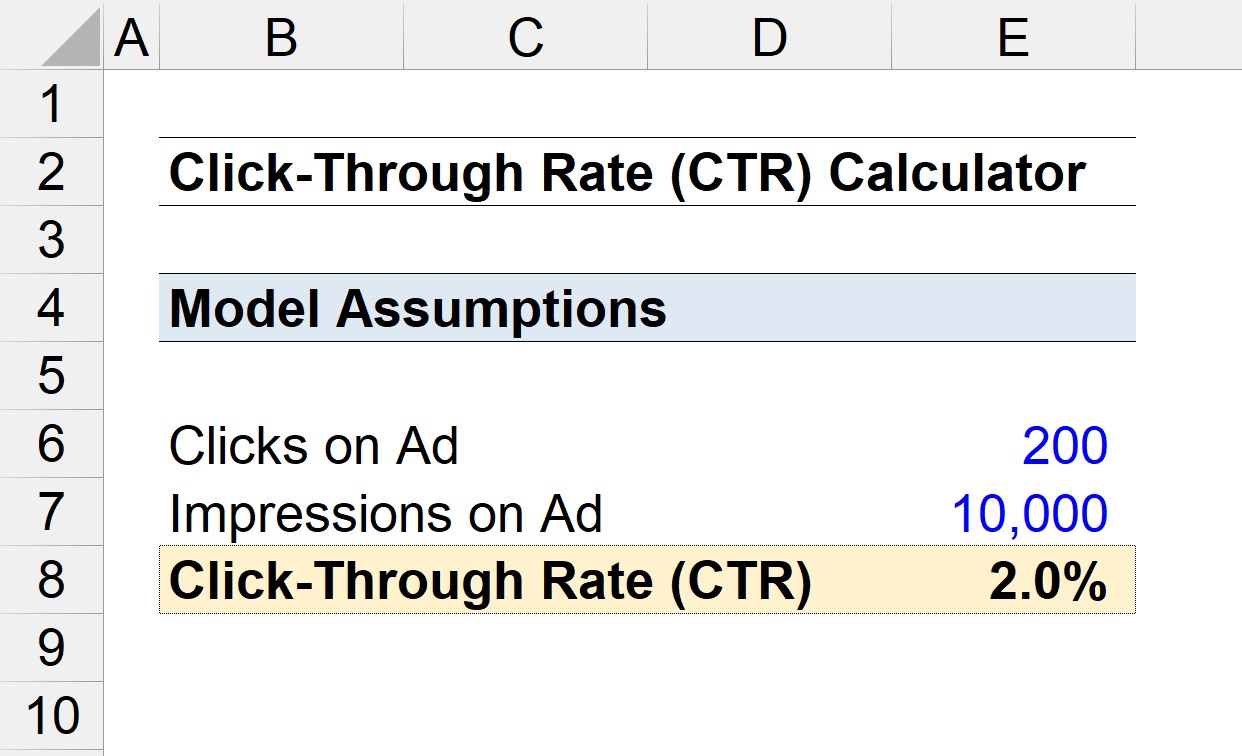What is Click-Through Rate?
The Click-Through Rate (CTR) measures the effectiveness of an ad by dividing the number of clicks on the ad (or link) by the total number of impressions.

How to Calculate Click-Through Rate (CTR)?
The CTR stands for “Click-Through Rate” and is a common metric used to track the performance of digital ad campaigns.
In short, the click-through rate (CTR) is the total number of users that “clicked” the ad divided by the total number of users that “saw” the ad.
Put differently, the CTR reflects the total number of clicks on an ad divided by the total impressions of the ad across a given time period.
There are three distinct variations of the click-through rate (CTR):
- Organic CTR → The CTR from organic search engine result pages, namely Google Search
- Email CTR → The CTR from email activities such as newsletters and email marketing campaigns
- Pay-Per-Click (PPC) CTR → The CTR from pay-per-click (PPC) ads
Search engines tend to attach a premium on sites with a high click-through rate (CTR), so the metric is of particular importance for pay-per-click (PPC) models.
CTR Formula
The formula for calculating the click-through rate (CTR) is as follows.
- Total Clicks on Ad → Number of Clicks Received
- Total Impressions → Number of Times the Ad (or Link) is Shown
For instance, if a website had 50 clicks and 1,000 impressions, then the CTR equals 5.0%
- Click-Through Rate (CTR) = 50 Clicks ÷ 1,000 Impressions = 5.0%
What is a Good CTR?
The click-through rate (CTR) on each marketing ad is often tracked to perform side-by-side comparisons to other ads run in the past, which helps establish which type of ad campaigns the target market is most receptive to.
- High Click-Through Rate → Positive Indication (Highly Relevant Ads)
- Low Click-Through Rate → Negative Indication (Less Relevant Ads)
A high CTR ad implies that users were intrigued by the content of the ad (and thus clicked on it).
A high CTR implies the company (and ad agency) is close to achieving the maximum traffic potential to the company site, directly increasing the odds of conversions due to the increased traffic.
On the other hand, a low CTR indicates that users either saw the ad and chose not to click on it, or simply ignored it.
Therefore, companies strive to improve their CTR so that the number of users clicking on their ads increase, which directly coincides with higher search rankings (and indirectly, more revenue via higher conversion rates).
CTR is a relative measure, meaning that it is not only industry-dependent but also affected by the set of keywords targeted.
The more competitive the industry (and the associated targeted keywords), the lower the average CTR is likely to be – albeit successful companies with optimal marketing strategies that have been perfected over time may still possess a high CTR.
For those established companies, a high CTR in a very crowded market represents a competitive edge, especially in modern times when digital marketing is of high importance.
How to Improve Click-Through Rate in Marketing?
In order to improve the click-through rate, a company should first develop a clear understanding of its target customer profile.
Some example questions to ask include the following:
- Q. What commonalities are shared among our most receptive customers with the lowest churn?
- Q. What is the goal of the customer when searching for the keyword?
- Q. What is the problem faced by the customer that our product/service can fix?
- Q. How can we make our solution more appealing to our customers (i.e. address their pain points)?
- Q. Which specific terms would “catch the attention” of our customers?
However, it is important to keep in mind that the ultimate end goal is driving conversions (i.e. sales).
Even if it leads to a click, intentionally misleading (i.e. deceptive) headlines ultimately bring no benefits if they do not ultimately drive the customer to complete a purchase.
Not to mention, ad placements can be costly, especially for the more crowded areas, so it is not cost-effective to pay for clicks that will not drive conversions.
CTR Calculator
We’ll now move to a modeling exercise, which you can access by filling out the form below.
Click-Through Rate Calculation Example
Suppose a company’s marketing department ran an ad in the past week that generated a total of 10,000 impressions and 200 clicks.
- Total Impressions on Ad = 10,000
- Total Clicks on Ad = 200
If we enter those two inputs into the CTR formula from earlier, we arrive at a click-through rate (CTR) of 2.0%.
- Click-Through Rate (CTR) = 200 ÷ 10,000 = 2.0%
The Wharton Online & Wall Street Prep Applied Value Investing Certificate Program
Learn how institutional investors identify high-potential undervalued stocks. Enrollment is open for the Feb. 10 - Apr. 6 cohort.
Enroll Today






